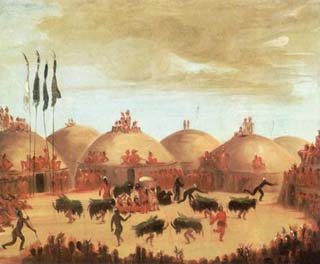Anth 3511 Professor Gibbon
Village Farmers of the Plains
Introduction. In the eastern Plains, the Archaic life-way - the cyclical or scheduled hunting of small game, the gathering of seeds, tubers, nuts, berries, and other vegetal foods in season - eventually gave rise to a number of locally and temporally distinct complexes, basically of eastern origin or else strongly influenced by eastern cultures. Two main traditions are recognized: an earlier Plains Woodland and a later Plains Village.
1. Plains Woodland (c. 250 BC - AD 950). The Plains Woodland tradition is characterized by the presence of eastern-style pottery and earthen burial mounds; a simple creek-valley hunting and gathering subsistence economy in which deer and small mammals were a more important source of protein than bison (except in the northwest); incipient horticulture (maize, beans, squash) that did not become important until the end of the period; many small sites, often deeply buried, scattered throughout the region from Oklahoma and Texas to North Dakota and the prairie provinces and, apparently in diminishing numbers, westward to the Rockies.
A. Kansas City Hopewell. An exception to the general Plains Woodland life style is the presence of relatively advanced and perhaps more sedentary eastern Hopewell sites near Kansas City in the Central Plains. Larger sites, which are as much as 3 or 4 hectares in size, have dense concentrations of refuse, numerous storage pits, and a varied assemblage of artifacts in pottery, stone, bone, and other materials. Hopewell pottery is usually plain with rocker markings and zone decoration (see Chap. 20). Ritual or power items include imitation bear teeth of bones and various objects made from stone, obsidian, copper, and clay.
(1) Common tools included large, corner-notched projectile points, three quarter-grooved axes, end and side scrapers, bone awls and scrapers, and tanged antler-tip projectile points.
B. Other Plains Woodland complexes usually have a simpler material-culture inventory. Pottery is cord roughened and decorated with single-cord impressions. Examples of regional complexes include Keith, Valley, Sterns Creek, and Loseke Creek in Nebraska and Kansas. The Pelican Lake, Besant, and Avonlea complexes are coeval equivalents of the Plains Woodland in the grasslands of southern Manitoba. Besant and Avonlea and associated as well with burial mounds and small amounts of ceramics. Avonlea sites provide the earliest evidence for the complex, ritualized, planned bison drives in the northern Plains. Projectile point forms and sizes change in the Plains Woodland by AD 300 or so from an Archaic dart weapons system to the bow and arrow system. Athabascans to the northwest may have been responsible for introducing into the northern Plains the bow and arrow and complex ritualized bison drives.
2. Plains Village Indians (AD 900-1850). Later complexes involved more sedentary settlements of substantial structures scattered along the permanent streams throughout much of the tall - and mid-grass prairies from the Dakotas and Texas, and westward into the short-grass plains of eastern Colorado. These people had a dual subsistence strategy involving, in varying proportions, the horticultural potential of the arable stream bottoms and the game and wild vegetable resources of the wooded bottomlands and the nearby grassy uplands.
A. Shared by most Plains Village complexes were: (1) fairly large, substantial, fixed multifamily lodges; (2) permanent settlements that are usually fortified with moats and stockades, and contain many underground storage pits; (3) lots of pottery; (4) a wide range of artifacts in stone, bone (e.g., the bison scapula hoe), horn, shell, and other material.
B. Central Plains and Middle Missouri traditions developed c. AD 900-1000. Each contains a number of taxonomic units (e.g., Monroe, Anderson, Thomas Riggs, and Huff phases of Initial and Extended Middle Missouri divisions, and the Upper Republican and Nebraska phases of the central Plains tradition). Following a drought in the 15th century, central Plains people moved up the Missouri River into "Middle Missouri tradition" territory to form a Coalescent tradition.
C. Similar groups (e.g., Custer, Washita, and Antelope Creek foci) formed in the Southern Plains.
D. Historic groups that developed out of Plains Village complexes include the Mandan, Hidatsa, and Arikara from the Middle Missouri tradition, the Pawnees from the Central Plains tradition, and the Wichita tribes from the Southern Plains tradition.
Go To The Index Page

